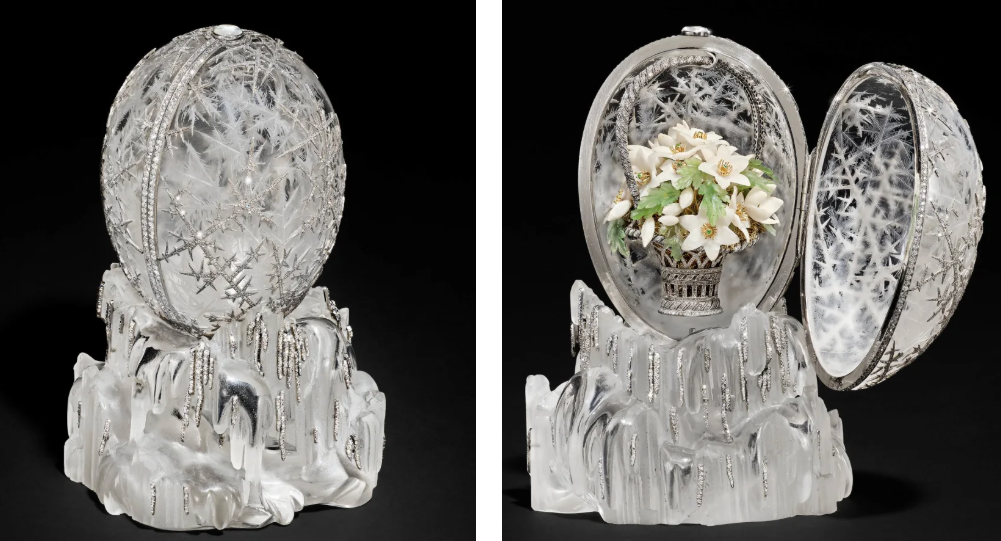The Fabergé Winter Egg, A Legendary Masterpiece Returns to Auction
A Jewel of Imperial Russia
The Fabergé Winter Egg has long been regarded as one of the most extraordinary achievements of the House of Fabergé, standing as a pinnacle of craftsmanship from Russia’s imperial era. Created in 1913 for Emperor Nicholas II as an Easter gift to his mother, Maria Feodorovna, the piece remains a breathtaking fusion of artistry, engineering and symbolism.
At just over 14 centimetres tall, the egg is carved from clear rock crystal and embellished with thousands of rose cut diamonds set in intricate frost patterns. Its platinum snowflakes shimmer delicately across the surface, highlighting the icy theme envisioned by Alma Theresia Pihl, one of the few female designers in Fabergé’s circle and a key figure in the creation of the Winter Egg. The exceptional craftsmanship was executed by her uncle, the celebrated workmaster Albert Holmström, whose precision elevated the piece into a category all its own.
Inside the egg rests its surprise, a tradition central to every imperial Fabergé creation. A tiny bouquet of wood anemones emerges from a gold and quartz composition, its green gold moss and nephrite leaves capturing a sense of spring breaking through winter, a symbolic gesture of renewal and hope.
A Storied Journey Through Turbulent Times
The Winter Egg has lived many lives. Following the Russian Revolution, many imperial treasures were seized or sold as the new government attempted to raise much needed funds. The Winter Egg was among the items dispersed, eventually making its way to London where it was purchased in the 1920s for just £450, a fraction of what its craftsmanship and history truly represented.
Over the next century it moved through the hands of prominent collectors, each sale pushing its value higher as interest in imperial artifacts grew. It resurfaced publicly in 1994 and sold again in the early 2000s, each time capturing global attention and setting record prices for Fabergé artistry.
Now, the Winter Egg is heading back to auction, with expectations that it will exceed previous records. Its estimate sits in the region of £20 million and rising, making it one of the most valuable decorative arts objects ever offered at auction. Only seven imperial eggs remain in private collections, a rarity that further amplifies its appeal and its financial significance.
Why the Winter Egg Commands Such Extraordinary Value
The Winter Egg is celebrated for far more than its precious materials. Rock crystal is notoriously difficult to carve, especially to the level of precision required for transparent surfaces. Achieving flawless clarity, engravings that resemble frost and a perfectly fitted platinum frame is a technical triumph. Adding more than four thousand diamonds to a structure this delicate required a level of skill unmatched by most jewelers of the time.
Its interior surprise carries its own technical marvels. Creating botanical realism from quartz and gold requires expertise more commonly associated with elite watchmaking and sculpture. The anemone bouquet brings warmth, emotion and poetry to a piece otherwise rooted in icy splendour.
This blend of technique, rarity, beauty and imperial provenance explains why the Winter Egg repeatedly captures the world’s attention. It is more than a luxury object, it is a cultural artifact that embodies artistry at its most ambitious.
A Moment That Could Reshape the Decorative Arts Market
The Winter Egg’s return to the auction block represents more than a sale. High net worth collectors view pieces like this as long term assets whose value is tied to scarcity, historical importance and global fascination. When exceptional items reach the market, they often recalibrate industry benchmarks.
A strong sale could influence pricing for decorative arts for years to come, pushing similar categories into new financial territory. Collectors and investors are increasingly viewing imperial Fabergé items as blue chip assets, comparable to masterworks of painting or sculpture, due to their limited supply, global recognition and extraordinary craftsmanship.
According to analysis reviewed by CEO Today, the market for rare historical pieces with strong storytelling has strengthened significantly, with top tier buyers seeking assets that combine cultural relevance, emotional resonance and long term financial potential. The Winter Egg embodies all three.
Why the World Still Cares About This Egg
The fascination with the Winter Egg goes beyond its diamonds and rock crystal shell. It represents a chapter of history filled with grandeur, revolution and rediscovery. Its survival is remarkable, its beauty undeniable and its story endlessly compelling.
In an age defined by disposable luxury, the Winter Egg stands as a reminder of what true craftsmanship means. It carries the energy of a vanished empire, the vision of gifted artisans and the promise of enduring value. As it prepares to find a new home, one thing is clear. Imperial Fabergé creations continue to hold the world spellbound more than a century after they were made.














